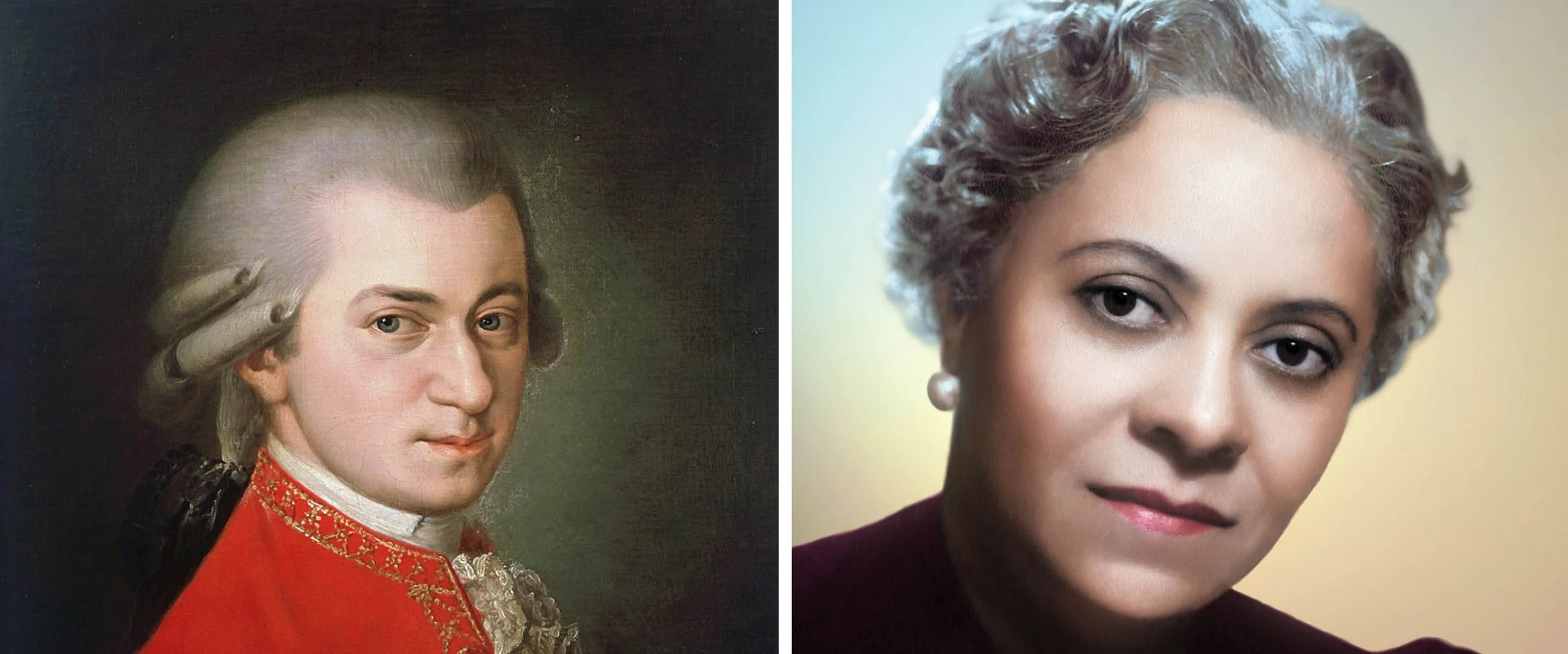Program Notes for MAy 12 & 13, 2023
Mozart Requiem
Wolfgang Amadeus Mozart
Requiem, K. 626 (completed by Robert Levin)
Composer: born January 27, 1756, Salzburg, Austria; died December 5, 1791, Vienna
Work composed: 1791. Mozart died before completing the Requiem, an anonymous commission from Count Franz Walsegg von Stuppach. The Requiem was originally finished by one of Mozart’s students, Franz Xaver Süssmayr. The version heard in these concerts was realized and completed by musicologist Robert Levin in 1991.
World premiere: Helmuth Rilling conducted the first performance of Levin’s realization in August 1991 at the European Music Festival in Stuttgart.
Instrumentation: soprano, alto, tenor and bass soloists, SATB chorus, 2 bassoons, 2 basset horns (or clarinets), 2 trumpets, 3 trombones, timpani, organ, and strings
Estimated duration: 53 minutes
The mysterious circumstances surrounding Wolfgang Amadeus Mozart’s Requiem have lent the work an aura of romance and intrigue almost as compelling as the music itself. In the summer of 1791, Count Franz Walsegg von Stuppach sent a messenger to Mozart with an anonymous commission for a Requiem intended to honor Walsegg’s late wife. Walsegg, an amateur musician, had a habit of commissioning works from well-known composers and then claiming them as his own, hence his need for anonymity and subterfuge. Chronically hard up, Mozart accepted the commission. He completed several sketches before putting the Requiem aside to finish Die Zauberflöte and La Clemenza di Tito and to oversee a production of Don Giovanni.
In October 1791, in failing health, Mozart returned to the Requiem. When Mozart died two months later, the Requiem remained unfinished. Mozart’s wife, Constanze, facing a mountain of debt, asked one of Mozart’s associates, Franz Xaver Süssmayr, to complete it. Süssmayr agreed, but his claims of authorship of the later movements of the Requiem have provoked sharp debates over which man wrote what, debates that continue today.
In 1991, musicologist Robert Levin presented his ‘completed’ version of the Requiem in which he corrected what he called Süssmayr’s “errors in musical grammar.” This version has become preferred by conductors and ensembles; since its premiere, there have been over 125 recordings of Levin’s edition.
The fine attention to detail in the meaning of the words of the requiem mass dictates the musical structure throughout. The chorus’ heartfelt pleading in the opening lines, “Requiem aeternam dona eis, Domine” (Grant them eternal rest, O God), are presented in a dark minor key. This is transformed into a promise of glowing eternity in the next sentence, “Et lux perpetua luceat eis” (and may perpetual light shine upon them) as the music moves into the light of a major key. The strong Kyrie (Lord, have mercy/Christ, have mercy) that follows is set in a stark fugue, Mozart’s homage to J. S. Bach.
The Sequence, which is composed of a number of short movements, begins with the Dies Irae (Day of Wrath), whose fiery, agitated setting and orchestral accompaniment bring the terror and fury of the text frighteningly alive. In the Tuba mirum, the bass soloist and a solo trombone proclaim the Day of Judgment, followed by each of the soloists in turn. The chorus returns to beg for salvation from hell in the powerful Rex tremendae, which is followed by the more intimate pleading of the Recordare, in which each of the soloists makes a personal petition to God. The gentleness of this movement is followed by the thunder of the Confutatis, which juxtaposes the images of the damned consigned to the flames of hell with that of the supplicant kneeling in prayer. Then comes the exquisite Lacrymosa, in which the chorus grieves and sobs; The sighing appoggiaturas of the violins echo the lamenting of the text. In the Offertory, the chorus ends its plea for mercy with a reminder of God’s promise to Abraham; these words are set into a tremendous fugue, which recurs at the end of the graceful Hostias.
With the Sanctus comes the first wholly joyful expression of emotion, as the chorus and orchestra together sing God’s praises with shining exclamations in the brasses and a fugue on the words “Hosanna in the highest.” The operatic grace of the melody of the Benedictus, sung by the four soloists, conveys the sense of blessedness of those “who come in the name of the Lord;” this is followed by a recurrence of the choral fugue from the Sanctus. With the Agnus Dei, the chorus and orchestra return to the darkly shifting mood of the opening movement; this culminates in the Communio, which uses the music of the opening Requiem aeternam and concludes with the same fugue used in the Kyrie, but this time on the words “cum sanctis tuis in aeternam” (with Thy saints forever).
Florence price
Symphony No. 3 in C minor
Composer: born April 9, 1887, Little Rock, AR; died June 3, 1953, Chicago
Work composed: 1938-39
World premiere: Valter Poole led the Michigan WPA Symphony Orchestra (aka the Detroit Civic Symphony) on November 6, 1940
Instrumentation: 4 flutes (1 doubling piccolo), 3 oboes (1 doubling English horn), 2 clarinets, bass clarinet, 2 bassoons, 4 horns, 3 trumpets, 3 trombones, tuba, timpani, bass drum, castanets, crash cymbals, gong, orchestral bells, sand paper, slapstick, snare drum, suspended cymbal, tambourine, triangle, wood block, xylophone, celesta, harp, and strings
Estimated duration: 28 minutes
Florence Price, the first Black female American composer to have a symphony performed by a major orchestra, enjoyed considerable renown during her lifetime. Her compositional skill and fame notwithstanding, however, the entrenched institutional racism and sexism of the white male classical music establishment effectively erased Price and her music from general awareness for decades after her death in 1953. More than 50 years later, in 2009, a large collection of scores and unpublished works by Price were discovered in a house in rural Illinois. Since then, many ensembles and individual musicians have begun including Price’s music in concerts, and audiences are discovering her distinctive, polished body of work for the first time.
The daughter of a musical mother, Price was a piano prodigy, giving her first recital at age four and publishing her first composition at 11. During her childhood and teens in Little Rock, Arkansas, Price’s mother was the guiding force behind her piano and composition studies. In 1903, at age 16, Price won admittance to New England Conservatory (she had to “pass” as Mexican and listed her hometown as Pueblo, Mexico, to circumvent prevailing racial bias against Blacks), where she double majored in organ performance and piano pedagogy. While at NEC, Price also studied composition with George Whitefield Chadwick. Chadwick was an early advocate for women composers, and he believed, as did Antonín Dvořák before him, that American composers should incorporate the rich traditions of American vernacular music into their own work, rather than trying to imitate European styles.
Price, already inclined in this direction, was encouraged by Chadwick; many of her works reflect the expressive, distinctive idioms of what were then referred to as “Negro” traditions: spirituals, ragtime, jazz, and folkdance rhythms whose origins trace back to Africa. In 1938, Price wrote, “We are even beginning to believe in the possibility of establishing a national musical idiom. We are waking up to the fact pregnant with possibilities that we already have a folk music in the Negro spirituals – music which is potent, poignant, compelling. It is simple heart music and therefore powerful. It runs the gamut of emotions.”
Price’s later works, including the Symphony No. 3, fuse these uniquely Black American musical idioms with the modernist European language employed by many classical composers of the day. Price explained, “[The Symphony No. 3 is] a cross section of present-day Negro life and thought with its heritage of that which is past, paralleled or influenced by concepts of the present day,” specifically, her use of the expressively dissonant harmonic language of the 20th century.
Each of the Third Symphony’s four movements juxtaposes elements of both musical traditions, often in opposition to one another. The Andante; Allegro opens with a slow, pensive introduction in which brasses and winds feature prominently. This gives way to the Allegro’s restless, harmonically unsettled first theme. A solo trombone introduces a contrasting second section, featuring original melodies grounded in the Black vernacular tradition. The pastoral quality of the Andante ma non troppo evokes the warm serenity of a summer afternoon, while the Juba, an African dance brought to America by enslaved people, transmits its infectious ebullience through syncopated rhythms and specific percussion accents, particularly the castanets and xylophone. The closing Scherzo combines Black-inflected rhythms and 20th-century harmonies in an orchestral showcase full of virtuosic passages.
© Elizabeth Schwartz
NOTE: These program notes are published here by the Modesto Symphony Orchestra for its patrons and other interested readers. Any other use is forbidden without specific permission from the author, who may be contacted at www.classicalmusicprogramnotes.com






















